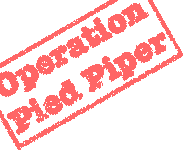
Evacuation Instructions
'OPERATION PIED PIPER'
THE GOVERNMENT EVACUATION SCHEME

The Government evacuation scheme had been planned by the 'Anderson Committee', a group led by Sir John Anderson. The Committee met between May and July 1938 and called in experts from railway companies, teachers and the police to advise them.
THE ANDERSON COMMITTEE RECOMMENDATIONS
Factories have to be kept open to produce important materials. People who are not doing essential jobs should be moved away from these factories, which will be targets for bombing.
EVACUATION SHOULD NOT BE COMPULSORY
Children not being evacuated with their mothers will be taken in school parties, with their teachers.
Evacuees will be housed in private dwellings. People in the reception areas will have to look after evacuees if they are asked to do so.
The British evacuation was called 'Operation Pied Piper'. It began on Friday 1 September 1939. The Government sent parents a list, telling them what they needed to pack for their children.
Most evacuees travelled to city railway stations to begin their journey to the countryside. Special timetables had to be arranged for the many extra train services. The evacuees did not know where they were travelling to.
FINDING BILLETS
A local 'billeting officer' was appointed to find suitable houses in all areas that were receiving evacuees.
In January and February 1939 the Government conducted an 'accommodation census' to find out how many billets were available. Local people called 'visitors' interviewed householders in reception areas, and filled in census forms. Officials used these forms to decide how many evacuees could be billeted in each area.
HOST FAMILIES
After a journey which was often long and tiring, evacuees had to line up and wait for a 'host family' to choose them.
Hosts received money for each evacuee they took in. They were paid by taking a form to the local post office.
Billeting was compulsory. People who refused to take evacuees into their homes without a good reason could be taken to court and fined.
It was not only billets that had to be found for evacuees. They also needed schools. Many teachers had been evacuated with their pupils, but it was not always easy to find them classrooms to teach in.
Not all evacuees came from poor areas. Some children found themselves evacuated from homes with bathrooms, to billets that had no facilities except a toilet at the bottom of the garden and a tin bath in front of the fire.
In 1944, a Women's Institute survey found that in 21 counties 50 per cent of village schools had only earth or bucket toilets.
GOING HOME
In April 1945, the Government sent out a timetable of travel arrangements to return the evacuees to their homes when the war was over. The return of the evacuees was much better organized than the original evacuation in 1939 had been.
Returning evacuees to their homes was not as easy as you might think. Some evacuees returned to find their homes destroyed by bombs. Others, whose parents had been killed, had nobody to go home to. Some evacuees could not even be found, because they had gone home early without telling anyone.
By 12 July 1945, 54,317 evacuees had returned to London. Over one hundred trains were used to transport them.
By August 1945 there were still 76,000 people in reception areas. These were people who either had no home to go to, or who did not want to return. When evacuation officially finished in March 1946
